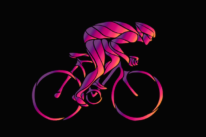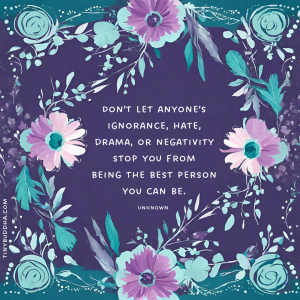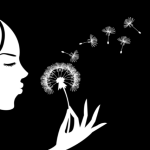
“You must learn to let go. Release the stress. You were never in control anyway.” ~Steve Maraboli
I’ve noticed that things go much more smoothly when I give up control—when I allow them to happen instead of making them happen. Unfortunately, I’m terrible at this.
Although I’m much better than I used to be, I’m a bit of a control freak. I often use perfectly good energy trying to plan, predict, and prevent things that I cannot possibly plan, predict, or prevent.
For example, I wonder if my baby is going to get a proper nap when we travel and, if not, just how crabby she might be. I think through her travel and napping patterns, attempting to figure out exactly what we’re up against, as if her sleep is something I can control.
I also think about the weather a lot when out-of-town guests are visiting. I spend my already-limited time planning for every possible weather/mood combination when considering our itinerary.
Like most humans I know, I spend a lot of time in business that’s not mine. The baby’s business, my friends’ business, Mother Nature’s business.
As a recovering control freak, there are three things I know for sure about trying to control things:
1. We try to control things because of what we think will happen if we don’t.
In other words, control is rooted in fear.
2. Control is a result of being attached to a specific outcome—an outcome we’re sure is best for us, as if we always know what’s best.
When we trust that we’re okay no matter what circumstances come our way, we don’t need to micromanage the universe. We let go. And we open ourselves to all sorts of wonderful possibilities that aren’t there when we’re attached to one “right” path.
3. The energy of surrender accomplishes much more than the energy of control.
I suspect it’s slightly different for everyone, but here’s what control mode looks and feels like for me: My vision gets very narrow and focused, my breath is shallow, adrenaline is pumping and my heart rate increases.
My mind shifts from topic to topic and from past to future very quickly, and I have little concentration, poor memory, and almost no present-moment awareness.
In surrender mode, I’m calm, peaceful. Breathing deeply, present in the moment. I see clearly and my vision extends out around me, allowing me to (literally) see the bigger picture.
So the great irony is that attempting to control things actually feels less in control. When I’m micro-managing and obsessing over details, I know I’m in my own way.
The Art of Surrender
Surrender literally means to stop fighting. Stop fighting with yourself. Stop fighting the universe and the natural flow of things. Stop resisting and pushing against reality.
Surrender = Complete acceptance of what is + Faith that all is well, even without my input.
It’s not about inaction. It’s about taking action from that place of surrender energy.
If letting go of control and surrendering not only feel better, but actually produce better results, then how do we do that?
Sometimes it’s as easy as noticing that you’re in control mode and choosing to let go—consciously and deliberately shifting into surrender energy.
For example, when I become aware that I’m in control mode, I imagine that I’m in a small boat paddling upstream, against the current. It’s hard. It’s a fight. That’s what control mode feels like to me.
When I choose to let go and surrender, I visualize the boat turning around, me dropping the oars, and floating downstream.
I’m being gently pulled, no effort necessary on my part. Simply breathing and saying, “Let go of the oars” is usually enough to get me there.
Sometimes it’s a little harder to make the shift from control to surrender. Here are a few questions that can help:
1. What am I afraid will happen if I let go of control?
When you pinpoint the fear, question its validity. Ask yourself, Is it true? If you’re afraid the night will be ruined if your boyfriend doesn’t remember to pick up eggplant (and you’ve already reminded him fourteen times), question that assumption.
Can you really know the night would be ruined without the eggplant? And if it would be ruined (by your definition, anyway), what’s so bad about that?
2. Find out whose business you’re in.
Your business is the realm of things that you can directly influence. Are you there? Or are you in someone else’s business? When we’re trying to control things outside of our own business, it’s not going to go well.
3. Consider this: Would letting go feel like freedom?
It almost always would. Let that feeling of freedom guide you toward loosening your grip.
A Friendly Universe
Einstein said, “The most important decision we make is whether we believe we live in a friendly or hostile universe.”
I believe in a friendly universe.
Being receptive and allowing things to happen is a skill that can be practiced and improved upon. It helps to believe in a friendly universe—one that is supporting you at every turn so that you don’t have to worry yourself over the details.
We can always choose to do things the easy way or the hard way. We can muscle through, or we can let go of the oars and let the current carry us downstream.
There is a peaceful, yet focused energy that accompanies holding the intention of what I want, but not forcing myself to do it. That energy is magic. I’m still a work in progress, but I’m allowing it to become a habit instead of making it a habit.
About Amy Johnson
Dr. Amy Johnson is the author of several books, including The Little Book of Big Change: The No-Willpower Approach to Breaking Any Habit. She is also the creator of The Little School of Big Change, an online school that helps people find lasting freedom from habits and anxiety. Please go here to get a free sneak preview of the school.













 Though I run this site, it is not mine. It's ours. It's not about me. It's about us. Your stories and your wisdom are just as meaningful as mine.
Though I run this site, it is not mine. It's ours. It's not about me. It's about us. Your stories and your wisdom are just as meaningful as mine.